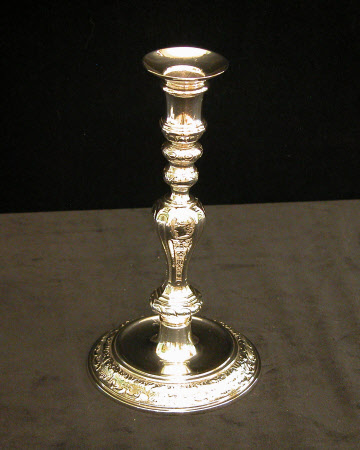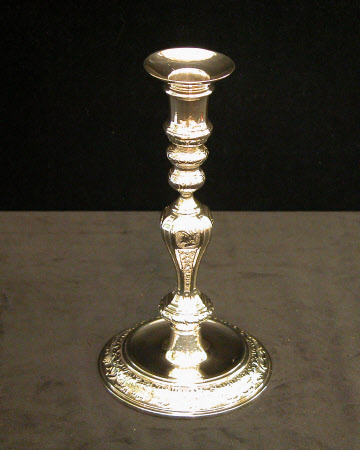Pair of candlesticks
Pierre Platel (b. c.1664, d.1719)
Category
Silver
Date
1708 - 1709
Materials
Silver
Measurements
21 cm (Height); 11.4 cm (Dia of base)
Place of origin
London
Order this imageCollection
Ickworth, Suffolk
NT 852112
Summary
Pair of Britannia silver candlesticks by Pierre Platel, London, 1708/9, the nozzles probably sterling, c. 1751. The circular feet with dished centres are cast and chased with borders of shells, scrolls and foliage. The cast and chased baluster stems rise from the dished centres to compressed circular knops decorated with a band of guilloche and rosettes above which are stepped octagonal bases. The stem is then wasted before swelling as an inverted octagonal tear-drop, decorated with four vertical panels comprising medallions of classical heads above ribbon-tied floral pendants, all on matted grounds. Between the panels are shallow flutes with matted grounds. The stems terminate in a pair of small knops chased with shells and C-scrolls on matted ground below and ovoid strapwork on foliate matted ground above. The cast and chased vase-shaped sockets each have a calyx of formal stiff palm leaves at the base. The plain, circular nozzles have seamed necks and raised, flaring wax pans.Heraldry: The dish of each base has been re-engraved c.1751 with the Hervey crest beneath an earl's coronet. Marks: Both fully marked on the underside, Britannia, lion’s head erased, date letter ‘N’, maker’s mark ‘PL’ with crown and star above, fleur de lis below (Grimwade 1990, no. 2200). Scratchweights: ‘No 14 [/] 15=0’ and [former weight] ‘13 – 9’; ‘No 13 [/] 14=8'.
Full description
Comparable French candlesticks with polygonal stems and classical medallions exist from the 1690s but the most direct design source seems to be Daniel Marot’s Nouveau livre d’orfèvrerie of 1703 in which a similar candlestick is illustrated.[1] The earliest English example appears to be the set of twelve at Welbeck Abbey of 1702 on which the maker’s mark is illegible,[2] and a near-identical foursome by David Willaume, probably of 1706.[3] The pattern, with slight variations, had great resilience over the next thirty years, its ornamentation particularly suiting the Régence love of crisp, intricate patterning and classical detail. The Ickworth pair departs from the other early examples in having an additional double knop detail immediately below the socket but this appears to be original and must have been Platel’s own inventive and possibly unique interpretation. The addition of the fixed nozzles, probably in the 1750s, is likely to explain the change in scratchweight. Frustratingly, as with so many of the surviving early pieces of silver in the Ickworth collection, these candlesticks cannot be directly linked with a payment in the 1st Earl of Bristol’s accounts. They and the following two pairs could, however, have formed part of the unspecified plate of Sir Thomas Felton, 4th Bt, purchased by Lord Bristol in October 1709 along with the chocolate pot (cat. 5), or that of Sir Thomas’s sister, Lady Howard of Effingham, bought on 23 April 1727 (see appendix 1 for details of these purchases). Both siblings may well have had fashionable plate from the early eighteenth century, though Sir Thomas is the more likely candidate given that he was at the heart of court affairs from 1689, as Master of the Household to William and Mary, and had been elevated to Comptroller by Queen Anne in 1708. Sir Thomas may well have seen Sir Robert Harley’s set of candlesticks of the same pattern (those now at Welbeck), issued to him by the Jewel Office on becoming Speaker of the House of Commons.[4] Had such candlesticks been amongst Felton’s plate Lord Bristol’s proven eye for a bargain suggests he would have been unlikely to have missed the opportunity to acquire items at the height of fashion for less than the residual value of the metal. He paid 5s 1d per ounce. James Rothwell, Decorative Arts Curator December 2020 [Adapted from James Rothwell, Silver for Entertaining: The Ickworth Collection, London 2017, cat. 7, pp. 74-5]. Notes: [1] For a comprehensive assessment of the pattern see James Lomax and James Rothwell, Country House Silver from Dunham Massey, 2006, p. 121. The Marot engraving is illustrated on p. 159, fig. 56. [2] JE. Alfred Jones, Catalogue of Plate Belonging to the Duke of Portland, 1935, p. 60. [3] Christie’s, 23 April 1966, lot 37 [4] The National Archives, LC 9/44, Jewel Office Delivery Book 1698–1732, f. 65.
Provenance
Possibly acquired by Sir Thomas Felton, 4th Bt (d. 1709) and from his estate by John, 1st Lord Hervey (subsequently 1st Earl of Bristol); by descent to the 4th Marquess of Bristol; accepted by the Treasury in lieu of death duties in 1956 and transferred to the National Trust.
Credit line
Ickworth, the Bristol Collection (National Trust)
Makers and roles
Pierre Platel (b. c.1664, d.1719), goldsmith

